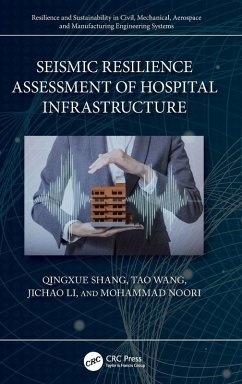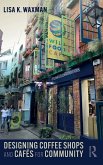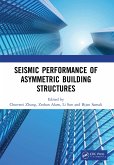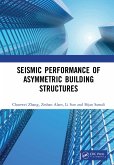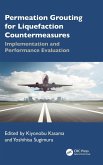Qingxue Shang, Tao Wang, Jichao Li, Mohammad Noori
Seismic Resilience Assessment of Hospital Infrastructure
Qingxue Shang, Tao Wang, Jichao Li, Mohammad Noori
Seismic Resilience Assessment of Hospital Infrastructure
- Gebundenes Buch
- Merkliste
- Auf die Merkliste
- Bewerten Bewerten
- Teilen
- Produkt teilen
- Produkterinnerung
- Produkterinnerung
Seismic Resilience Assessment of Hospital Infrastructure presents a suite of novel techniques developed by the authors and their team for seismic resilience assessment of hospital infrastructure, with particular emphasis on seismic tests and fragility models of hospital equipment and the resilience of hosptial buildings.
Andere Kunden interessierten sich auch für
![Designing Coffee Shops and Cafés for Community Designing Coffee Shops and Cafés for Community]() Lisa WaxmanDesigning Coffee Shops and Cafés for Community197,99 €
Lisa WaxmanDesigning Coffee Shops and Cafés for Community197,99 €![Seismic Performance of Asymmetric Building Structures Seismic Performance of Asymmetric Building Structures]() Chunwei ZhangSeismic Performance of Asymmetric Building Structures80,99 €
Chunwei ZhangSeismic Performance of Asymmetric Building Structures80,99 €![Seismic Performance of Asymmetric Building Structures Seismic Performance of Asymmetric Building Structures]() Chunwei ZhangSeismic Performance of Asymmetric Building Structures177,99 €
Chunwei ZhangSeismic Performance of Asymmetric Building Structures177,99 €![Earthquake Resistant Design of Buildings Earthquake Resistant Design of Buildings]() Muhammad HadiEarthquake Resistant Design of Buildings251,99 €
Muhammad HadiEarthquake Resistant Design of Buildings251,99 €![Seismic Resistant Design and Technology Seismic Resistant Design and Technology]() Dentcho IvanovSeismic Resistant Design and Technology190,99 €
Dentcho IvanovSeismic Resistant Design and Technology190,99 €![Earthquake Engineering and Structural Control Earthquake Engineering and Structural Control]() Srinivasan ChandrasekaranEarthquake Engineering and Structural Control122,99 €
Srinivasan ChandrasekaranEarthquake Engineering and Structural Control122,99 €![Permeation Grouting for Liquefaction Countermeasures Permeation Grouting for Liquefaction Countermeasures]() Permeation Grouting for Liquefaction Countermeasures110,99 €
Permeation Grouting for Liquefaction Countermeasures110,99 €-
-
-
Seismic Resilience Assessment of Hospital Infrastructure presents a suite of novel techniques developed by the authors and their team for seismic resilience assessment of hospital infrastructure, with particular emphasis on seismic tests and fragility models of hospital equipment and the resilience of hosptial buildings.
Hinweis: Dieser Artikel kann nur an eine deutsche Lieferadresse ausgeliefert werden.
Hinweis: Dieser Artikel kann nur an eine deutsche Lieferadresse ausgeliefert werden.
Produktdetails
- Produktdetails
- Verlag: CRC Press
- Seitenzahl: 212
- Erscheinungstermin: 14. März 2024
- Englisch
- Abmessung: 234mm x 156mm x 14mm
- Gewicht: 499g
- ISBN-13: 9781032600802
- ISBN-10: 1032600802
- Artikelnr.: 69433674
- Herstellerkennzeichnung
- Libri GmbH
- Europaallee 1
- 36244 Bad Hersfeld
- gpsr@libri.de
- Verlag: CRC Press
- Seitenzahl: 212
- Erscheinungstermin: 14. März 2024
- Englisch
- Abmessung: 234mm x 156mm x 14mm
- Gewicht: 499g
- ISBN-13: 9781032600802
- ISBN-10: 1032600802
- Artikelnr.: 69433674
- Herstellerkennzeichnung
- Libri GmbH
- Europaallee 1
- 36244 Bad Hersfeld
- gpsr@libri.de
Dr. Qingxue Shang obtained his bachelor's degree from Southeast University, China, in 2015. He obtained his master's and PhD degrees from the Institute of Engineering Mechanics, China Earthquake Administration, in 2018 and 2021, respectively. He worked as a postdoctoral researcher at Tsinghua University and then joined China Earthquake Disaster Prevention Center in 2023. He has got the support of the Natural Science Foundation of China Youth Fund Project, National Key Research and Development Plan Project, China Postdoctoral Science Foundation, and Shuimu Tsinghua Scholar Program. His research aims to evaluate and improve the seismic resilience of our society and community. His recent works and publications include the resilience assessment of hospital systems, power systems, and water distribution networks, and some resilience enhancement techniques including resilient shear wall structures and resilient nonstructural components. He worked as an Individual Research Member of the International Association for the Seismic Performance of Non-Structural Elements (SPONSE) and an Early Career Editor of Earthquake Engineering and Resilience. He is also an active reviewer for many international journals, including Reliability Engineering & System Safety, Earthquake Engineering and Structural Dynamics, Sustainable Cities and Society, International Journal of Electrical Power and Energy Systems, Structures, Earthquake Engineering and Engineering Vibration, and Advances in Bridge Engineering. Professor Tao Wang earned his bachelor's and PhD degrees from Tsinghua University, China and Kyoto university, Japan, respectively. His research commits to solve key scientific problems in reproduction of engineering failure mechanism and resilient earthquake engineering. His research findings have facilitated seismic resilience improvement of several important engineering projects. He has established extensive relations of cooperation with many experts from different countries to jointly promote seismic resilience evaluation and promotion work. He has organized an international special issue on seismic resilience and established the Huixian International Forum on Earthquake Engineering for Young Researchers, which attracted more than 600 young scholars from 30 countries to join. He has won the Second Prize of the China National Science and Technology Progress Award and many other important awards. He is a leading talent in science and technology of the China Earthquake Administration (CEA), and recently, he has won the Outstanding Youth Fund of the National Natural Science Foundation of China. Dr. Jichao Li obtained his bachelor's degree from Tsinghua University, China, in 2012. He obtained his PhD degree from the Institute of Engineering Mechanics (IEM), China Earthquake Administration, in 2018. He is currently an associate professor at IEM. His research focuses on seismic resilience analysis method, resilience improvement technology, and intelligent vibration control theory of engineering systems. He has got the support of the Natural Science Foundation of China Youth Fund project, Heilongjiang Provincial Natural Science Foundation joint guiding project, Basic Scientific Research Business Project of the Central Public Welfare Research Institute, and National Key Research and Development Plan. Professor Mohammad Noori is a professor of mechanical engineering at Cal Poly, San Luis Obispo, a fellow and life member of the American Society of Mechanical Engineering, and a recipient of the Japan Society for Promotion of Science Fellowship. His work in nonlinear random vibrations, seismic isolation, and application of artificial intelligence methods for structural health monitoring is widely cited. He has authored over 300 refereed papers, including over 160 journal articles and 6 scientific books, and has edited 25 technical, and special journals, volumes. He has supervised over 90 graduate students and post-doc scholars, and has presented over 100 keynote, plenary, and invited talks. He is the founding co-chief editor of an international journal and has served on the editorial board of over 15 other journals and as a member of numerous scientific and advisory boards. He has been a distinguished visiting professor at several highly ranked global universities, and directed the Sensors Program at the National Science Foundation in 2014. He has been a founding director or co-founder of three industry-university research centers and held chair professorships at two major universities. He served as the dean of engineering at Cal Poly for 5 years, has also served as the Chair of the National Committee of Mechanical Engineering Department Heads, and was one of the seven co-founders of the National Institute of Aerospace, in partnership with NASA Langley Research Center.
1. Introduction and Background 2. Seismic Force Demands on
Acceleration-Sensitive Nonstructural Components 3. Floor Response Spectra
for Seismic Design and Tests of Nonstructural Components 4. Shaking Table
Tests and Seismic Fragility Analysis of Typical Hospital Equipment 5. A
Quantitative Framework to Evaluate the Seismic Resilience of Hospital
Systems 6. Seismic Resilience Assessment of Emergency Departments Based on
the State Tree Method 7. Infrastructure Systems and Healthcare Network in a
Benchmark City 8. Post-Earthquake Healthcare Service Accessibility in a
Benchmark City 9. Summary and Remarks
Acceleration-Sensitive Nonstructural Components 3. Floor Response Spectra
for Seismic Design and Tests of Nonstructural Components 4. Shaking Table
Tests and Seismic Fragility Analysis of Typical Hospital Equipment 5. A
Quantitative Framework to Evaluate the Seismic Resilience of Hospital
Systems 6. Seismic Resilience Assessment of Emergency Departments Based on
the State Tree Method 7. Infrastructure Systems and Healthcare Network in a
Benchmark City 8. Post-Earthquake Healthcare Service Accessibility in a
Benchmark City 9. Summary and Remarks
1. Introduction and Background 2. Seismic Force Demands on
Acceleration-Sensitive Nonstructural Components 3. Floor Response Spectra
for Seismic Design and Tests of Nonstructural Components 4. Shaking Table
Tests and Seismic Fragility Analysis of Typical Hospital Equipment 5. A
Quantitative Framework to Evaluate the Seismic Resilience of Hospital
Systems 6. Seismic Resilience Assessment of Emergency Departments Based on
the State Tree Method 7. Infrastructure Systems and Healthcare Network in a
Benchmark City 8. Post-Earthquake Healthcare Service Accessibility in a
Benchmark City 9. Summary and Remarks
Acceleration-Sensitive Nonstructural Components 3. Floor Response Spectra
for Seismic Design and Tests of Nonstructural Components 4. Shaking Table
Tests and Seismic Fragility Analysis of Typical Hospital Equipment 5. A
Quantitative Framework to Evaluate the Seismic Resilience of Hospital
Systems 6. Seismic Resilience Assessment of Emergency Departments Based on
the State Tree Method 7. Infrastructure Systems and Healthcare Network in a
Benchmark City 8. Post-Earthquake Healthcare Service Accessibility in a
Benchmark City 9. Summary and Remarks

